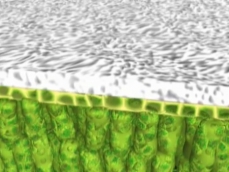Transcription of video clip Cells and water
Adapting to water shortages
Oleander (Nerium oleander) leaves are drought resistant.
To survive in an arid environment, an oleander has to limit transpiration through its leaves.

© Dr Lawrence Jensen, Honorary Senior Lecturer, University of Auckland
In white, the cuticle
The upper leaf surface, which is more exposed to the heat of the sun, has a thick, waxy coating.
Called the cuticle, it limits transpiration by the epidermal cells.
In addition, this side of the leaf has no stomata, the openings responsible for gas exchange with the air.

© Dr Lawrence Jensen, Honorary Senior Lecturer, University of Auckland
Air is stagnant inside the stomatal crypts.
Instead, the stomata are on the underside of the leaf, at the base of pits called stomatal crypts.
These crypts, covered in miniscule hairs, contain stagnant air and a moister microclimate.
When the leaf opens its stomata, it loses less water through transpiration than if the gas exchanges occurred directly in the dryer ambient air.
All these adaptations - stomatal crypts, hairs and cuticle - are essential to the oleander's survival in its arid environment, because they limit transpiration through its leaves.
Back to video clip




